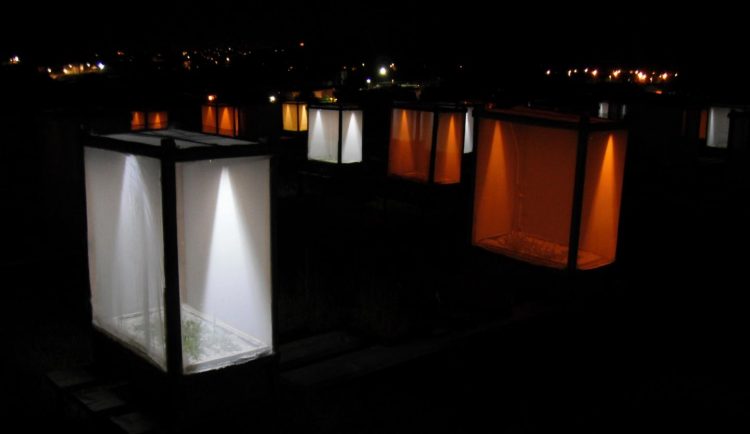Light pollution shown to affect plant growth and food webs

Researchers from the University of Exeter simulated the effects of street lighting on artificial grassland plots containing a community of invertebrates at night, exposing them to two different types of light treatment - a 'white' light similar to newer commercial LED street lighting systems and an 'amber' light simulating the type of sodium street lamp still found in much of the UK. The experiments investigated both top-down (driven by predators) and bottom-up (food or resource limited) effects of the lights on the population density of a species of pea aphid, and in the presence and absence of predators including ladybirds Credit: Jon Bennie/University of Exeter
The research shows that light pollution can impact the natural environment in complex ways that may be hard to predict. Due to the global extent of artificial light at night, there are concerns that these ecological impacts may be widespread.
Researchers from the University of Exeter simulated the effects of street lighting on artificial grassland plots containing a community of invertebrates at night, exposing them to two different types of light treatment – a 'white' light similar to newer commercial LED street lighting systems and an 'amber' light simulating the type of sodium street lamp still found in much of the UK.
The experiments investigated both top-down (driven by predators) and bottom-up (food or resource limited) effects of the lights on the population density of a species of pea aphid, and in the presence and absence of predators including ladybirds.
The low intensity amber light was shown to inhibit, rather than induce, flowering in greater bird's foot trefoil, a wild relative of peas and beans that is a key source of food for the pea aphid in grasslands and road verges. In mid summer aphids feed on the flowering shoots; the number of aphids was significantly suppressed under the light treatment in mid-August due to the limited amount of food available.
Professor Kevin Gaston, Director of the Environment and Sustainability Institute (ESI) said: “These are the first findings from major long-term experiments being funded by the European Research Council, and already reveal how profound the impacts of artificial night time lighting can be on even simple communities of organisms.”
Dr Jonathan Bennie of the ESI added: “Our results suggest that by lighting up our night time environment we trigger complex effects on natural food webs. While we are all aware that street lights often attract insects at night, we show that they may have more permanent, widespread impacts on wildlife and ecosystems.”
###
'Cascading effects of artificial light at night: resource-mediated control of herbivores in a grassland ecosystem' by Jonathan Bennie, Thomas W. Davies, David Cruse, Richard Inger and Kevin J. Gaston is published in the journal Philosophical Transactions of the Royal Society B.
The paper is part of a special themed issue of the journal entitled 'The biological impacts of artificial light at night: from molecules to communities', organised and edited by Kevin Gaston, Marcel Visser and Franz Hölker.
Media Contact
All latest news from the category: Life Sciences and Chemistry
Articles and reports from the Life Sciences and chemistry area deal with applied and basic research into modern biology, chemistry and human medicine.
Valuable information can be found on a range of life sciences fields including bacteriology, biochemistry, bionics, bioinformatics, biophysics, biotechnology, genetics, geobotany, human biology, marine biology, microbiology, molecular biology, cellular biology, zoology, bioinorganic chemistry, microchemistry and environmental chemistry.
Newest articles

Bringing bio-inspired robots to life
Nebraska researcher Eric Markvicka gets NSF CAREER Award to pursue manufacture of novel materials for soft robotics and stretchable electronics. Engineers are increasingly eager to develop robots that mimic the…

Bella moths use poison to attract mates
Scientists are closer to finding out how. Pyrrolizidine alkaloids are as bitter and toxic as they are hard to pronounce. They’re produced by several different types of plants and are…

AI tool creates ‘synthetic’ images of cells
…for enhanced microscopy analysis. Observing individual cells through microscopes can reveal a range of important cell biological phenomena that frequently play a role in human diseases, but the process of…





















